Glenn Sanders asked how my recent reduction in the amount of track has affected operations on the layout. In a word (or two), it’s better.
Let me share a bit of the back story. I’ve been stone cold toward the layout for the last year or so. The fun parts for me were basically over and while I tried to find new ways to pursue the hobby, they weren’t holding my interest as strongly as I hoped. If I don’t have an engaging challenge of some kind, I simply lose all interest. I’m hardly unique, I think that happens to all of us.
I decided that much of the scenery wasn’t up to my desired standards, so large portions of it came out. I was never really happy with the area over the workbench and didn’t know what to do beyond ripping it all out and starting from zero again. I wasn’t thrilled with that idea at all, so things just sat and gathered dust.
I’d put a lot of time and effort into the track and, truth be told, it had become too precious in my mind. In other words, I was very reluctant to make changes to it, even good ones. Finally, the level of frustration boiled over and I removed one of the yard tracks over the bench. I’ve shared that story on the blog already so I won’t repeat it here.
This helped, but my enthusiasm was still pretty low because other things about the layout still bothered me. The main frustration was it was still too crowded and disjointed visually, so more dust gathered over time.
While all this dust was gathering, I was reading Lance Mindheim’s writings about smaller, simpler layouts and operations and it really resonated with me. Trevor Marshall was also doing some very interesting things with operations on his layout which I also liked. Recently, I was deep into the work with Vol. 5 of The Missing Conversation about switching operations and learned a great deal that I never knew previously. So after a lot of thought and staring at the layout, then playing with an idea in Photoshop, one day a few weeks ago, I just walked into the layout room and starting removing track. It was a good move.
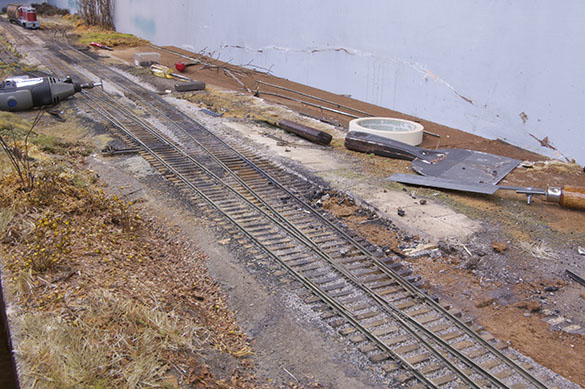
I removed half of the No.10 crossover and patched the track. The track alignment here is now closer to the actual Valley Junction. Long time readers may recall that a dense wooded hillside was located behind the tracks here. The future scenery treatment will be more pedestrian in nature for a more accurate reflection of VJ.
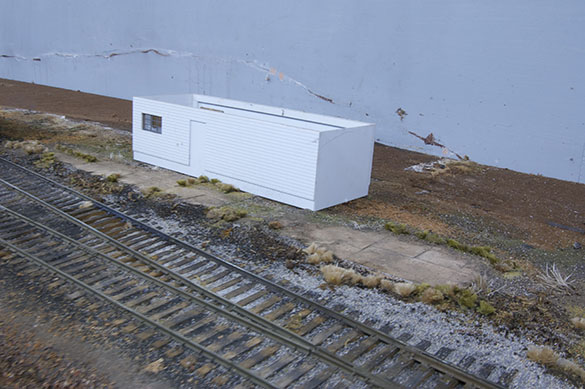
This model of a mobile office trailer represents current practice on the line. It will be surrounded by parking and a service road to the yard. Trees and encroaching vegetation will smooth the transition from the layout to the backdrop. The old concrete platform was modeled after the one at West Harrison IN a few miles up the branch. It isn’t accurate for VJ but it will stay. I plan to park the locomotive here between tricks.
Now to Glenn’s question.
The first thing I noticed was how having less track helped me focus while operating. Without the excess track to fall back on, I had to concentrate on the moves and their sequence just like the full-size railroaders do. In my view, this is beneficial in numerous ways, in that I’m more engaged with the work and the scenery feels more open, making the layout as a whole seem larger.
The second thing I noticed was that the scene more closely resembled the Valley Junction of today that I see on my field trips rather than the freelanced version I had built. The former version was accurate with regard to the track layout, but it never resonated as deeply because I couldn’t relate to it visually. Things were simply too crowded on the layout as a whole, which destroyed much of the openness I saw at Valley.
What was I thinking?
I included so much track originally because I thought I would need it for “operational interest.” (A phrase I want to banish from my vocabulary.) The tracks I removed were mostly facing point, meaning they required a run-around move to spot cars. I thought the middle track near the mill would serve as a switch lead, allowing me to pull both yard tracks at once. I seldom used it that way, and since the yard only had one track now, the long switch lead wasn’t needed anymore. The Mill Track had a car spot with a below track conveyor pit for covered hopper unloading but, this could be moved elsewhere, to the Pole Track for example, without loosing the operation.
As with Valley Junction, I treat the layout as Yard Limits trackage. This allows me to go where I need to in order to make a move. Since the layout is a one train operation, this is more of a mental formality than requirement. At the actual Valley junction crews will use the former main as needed for switching, without the worry of blocking through traffic. Further, cars can be spotted anywhere if needed, even on the branch itself, as I’ve witnessed more than once.
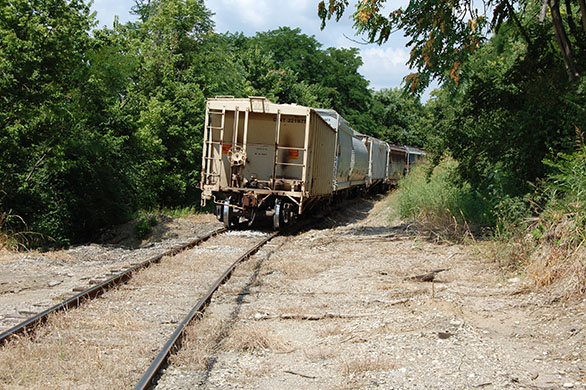
One day while I was photographing the yard, I noticed this cut of cars sitting on the branch just across US 50. No idea why there were left here. No room at the inn perhaps?
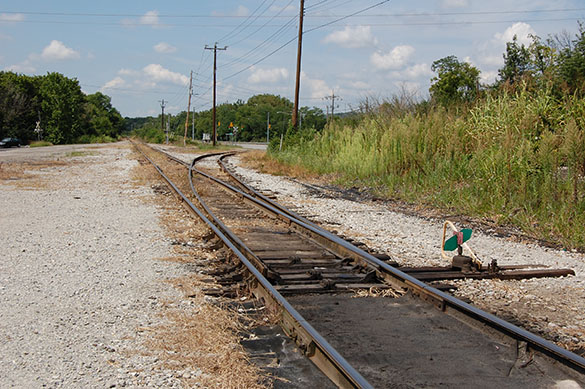
Looking west down the former NYC secondary from Cincinnati to Indianapolis. This was once a double track line, with a third track to the far left. No longer a through track, crews use it as a switch lead for working the yard. The branch to Brookville veers off to the right. Trees and other vegetation are reclaiming the wide right-of-way where the other tracks once ran.
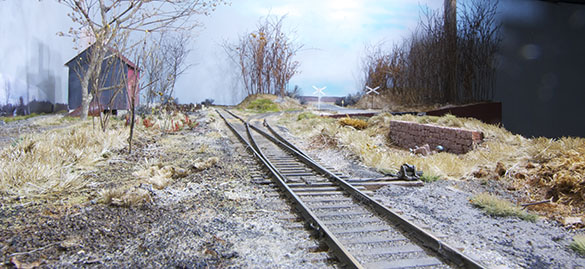
The same view on the layout. This is more satisfying than the previous rendition, which was full of track in this location. I have a lot more work to do on the scenery around the mill and at the end of track to ease the transition to the backdrop before I’m satisfied with things. The gold bricking employee near the old canal lock may be seeking other opportunities soon. Viewing the scene from the aisle, most people never even know he’s there.
I’ve found I don’t miss the old trackage at all. I prefer slow, very informal sessions. Like Lance, I find short, but frequent sessions to be more satisfying than the traditional full-blown, multi-hour formal sessions typically featured by the operations crowd. Once again, this is just my personal choice. Your mileage will vary. Glenn, I hope this answers your question.
Regards,
Mike
Related posts
One Layout or Two
Weeding The Yard
Ergonomic Realities
Interesting experiences there, Mike.
If I may take you to task over these two sentences, however:
I included so much track originally because I thought I would need it for “operational interest.” (A phrase I want to banish from my vocabulary.)
I understand your point, but you have interpreted “interesting” in terms of quantity. As Trevor has shown on Port Rowan, it is the quality of operations which are essential to maintaining interest: moving at a slow speed, drawing up to make sure that couplers are aligned – and pulling back if they are not – pausing to pump up the air, perform a test, and then the pump up the air again before setting off. Also, concentration on quality rather than quantity means that you, as operator, can enjoy the realism of the scene you have created with less track and number 10 turnouts. In fact, I would suggest that use of number 6 turnouts would be counter productive in these circumstances as the realism of movement would be destroyed.
There is nothing wrong with the phrase “operational interest”, or at least we need to reclaim the phrase and give it a wider meaning, so that freedom layouts are seen to be operationally interesting.
Incidentally, I have nothing against large layouts with multi-track yards using number 6 turnouts, as they aim at a different type of realism, that of shifting loads, cars and trains. That is simply not my personal bag.
Simon
PS: This view is simply stunning.
Hi Simon,
“I understand your point, but you have interpreted “interesting” in terms of quantity.”
Yes, in the sense of that is how it is typically used by the advocates of more track equals more operation. You and I, among a growing number of others, understand a different meaning: that being the one one you outlined.
I’m in total agreement with your comments and perhaps should have thought my wording through more carefully. What I wish to banish from my thinking is the mindset that you need more track, or more of whatever in order to have a satisfying layout. This is simply a bill of goods we’ve been sold over the years.
I like the thought of yours about reclaiming the language. Words mean things whether we wish to keep to a stricter definition or desire a more fluid interpretation. Our use of language within the hobby has become careless with obvious and not so obvious consequences as a result.
Thanks for keeping me honest Simon. And thank you for the compliment about the photo. I took the liberty of removing the duplicate comment without the link.
Regards,
Mike
Mike,
I am glad you didn’t think though your words “more carefully”, as this has opened up a conversation which would otherwise have been missing. That’s not a terrible pun, but an intentional choice of words.
Thanks for removing the extraneous link. I have had an email from Geoff Forster (of “Penhydd” fame) in which he also comments on that photo, with the words: “the closing photo is brilliant and just goes to show how the simple approach can pay off. What he has lost in track he has gained in atmosphere”
Simon
I’m flattered. Please convey my appreciation to Geoff for his kind words, and also that I’m a fan of his work.
Mike
Mike,
I have to agree with Simon. It is the quality, not quantity of operations that make a model interesting. Your end result looks more interesting in photos and you have taken into consideration the operations of the yard.
Most modelers, including myself, have limited modeling time. Working with the idea of less will in the end give you more satisfaction. Enjoy the new layout!
Matt
Will do, but he reads this blog, so probably knows already.
Thanks Matt, I am enjoying the layout more these days.
Mike
Hello Mike
Thanks for the update. I note with interest that much of the reasons you have enjoyed the ‘new’ arrangement is the visual relationship to VJ such as the openness and operating scheme – will more elements be up for the cut soon?
I like your mobile office trailer project. I think it will firmly set the timeline you are after when there are no locos present.
Coming back to your interest in decaying overgrown short line track work, perhaps the multiple track arrangement was also fundamentally ajar with the rundown nature you are trying to project. A bare bones operation is unlikely to keep more track than it needs to.
Thanks for the update and glad to hear your renewed enthusiasm. My own ideas are progressing well with some orders placed and a wealth of operating information and standards recently found online.
Look forward to your next installment
Glenn
Hi Glenn,
Thanks for the kind words.
You touched on some interesting points that I hadn’t thought of consciously, but as you suggested, perhaps they were making themselves known subconsciously. I think you’re right, the density of the number of tracks was at odds with what I saw when railfanning the line.
In quarter-inch scale it is so easy to overwhelm a given space with track because of the room it requires. This quickly becomes apparent in the design stages and is a prime reason many people ignore the scale. They simply can’t reconcile the number of features they desire with the amount of space available for them, without resorting to severe compromises.
As for my own progress, I think I have pared things downs to the point of sufficiency. The amount and configuration of the track feels much better and I don’t know what else I would remove at this point. There is ample room for the scenic treatments I desire, and operations are more interesting than before. So I think the layout is closing in on it’s optimal state.
I’ll be interested to learn about your own progress.
Regards,
Mike
Hi Mike,
I have long been a fan of the ‘less can mean more’ approach and your closing photo really shows just how effective it can be. You have created an extremely atmospheric scene there which also gives a feeling of place. I keep returning to that photo and each time my eye picks up something new. There are so many interesting textures,shapes and features which bring the scene alive.
A simple method of operation with little track can be very rewarding, I used to run Penhydd at a very leisurely pace. Over the course of a week or so I would work through a sequence with each movement having a purpose and would just wander into the railway room as I saw fit to pick up where I had left off. It has already been pointed out here the quality of operation is far better than quantity and I fully concur.
Your piece on backscenes was also spot on, keeping the horizon low with a big sky creates real depth. In closing I would like to thank you for taking an interest in my own modelling and for the kind comments you have made.
Thank you and Best Wishes,
Geoff
Thank you Geoff! It’s wonderful to hear from you. I came to your Chronicles of Pennhydd blog fairly late and enjoyed catching up. I’m also following your new project with great interest. I appreciate the kind words about the work. With a tighter focus, the layout is more enjoyable than ever.
Regards,
Mike